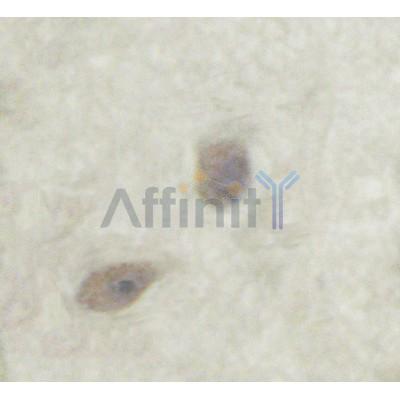产品描述
*The optimal dilutions should be determined by the end user.
*Tips:
WB: 适用于变性蛋白样本的免疫印迹检测. IHC: 适用于组织样本的石蜡(IHC-p)或冰冻(IHC-f)切片样本的免疫组化/荧光检测. IF/ICC: 适用于细胞样本的荧光检测. ELISA(peptide): 适用于抗原肽的ELISA检测.
引用格式: Affinity Biosciences Cat# AF3405, RRID:AB_2834788.
展开/折叠
14-3-3-zetaisoform; AI098070; aPKCzeta; C80388; EC 2.7.11.13; KPCZ_HUMAN; nPKC zeta; nPKC-zeta; OTTHUMP00000001368; OTTHUMP00000044160; PKC 2; PKC ZETA; PKC2; Pkcz; PKCZETA; PKM-zeta, included; PRKCZ; Protein kinase C zeta; Protein kinase C zeta form; Protein kinase C zeta type; r14-3-3; R74924; zetaPKC;
抗原和靶标
A synthesized peptide derived from human PKC zeta around the phosphorylation site of Thr560.
- Q05513 KPCZ_HUMAN:
- Protein BLAST With
- NCBI/
- ExPASy/
- Uniprot
MPSRTGPKMEGSGGRVRLKAHYGGDIFITSVDAATTFEELCEEVRDMCRLHQQHPLTLKWVDSEGDPCTVSSQMELEEAFRLARQCRDEGLIIHVFPSTPEQPGLPCPGEDKSIYRRGARRWRKLYRANGHLFQAKRFNRRAYCGQCSERIWGLARQGYRCINCKLLVHKRCHGLVPLTCRKHMDSVMPSQEPPVDDKNEDADLPSEETDGIAYISSSRKHDSIKDDSEDLKPVIDGMDGIKISQGLGLQDFDLIRVIGRGSYAKVLLVRLKKNDQIYAMKVVKKELVHDDEDIDWVQTEKHVFEQASSNPFLVGLHSCFQTTSRLFLVIEYVNGGDLMFHMQRQRKLPEEHARFYAAEICIALNFLHERGIIYRDLKLDNVLLDADGHIKLTDYGMCKEGLGPGDTTSTFCGTPNYIAPEILRGEEYGFSVDWWALGVLMFEMMAGRSPFDIITDNPDMNTEDYLFQVILEKPIRIPRFLSVKASHVLKGFLNKDPKERLGCRPQTGFSDIKSHAFFRSIDWDLLEKKQALPPFQPQITDDYGLDNFDTQFTSEPVQLTPDDEDAIKRIDQSEFEGFEYINPLLLSTEESV
种属预测
score>80的预测可信度较高,可尝试用于WB检测。*预测模型主要基于免疫原序列比对,结果仅作参考,不作为质保凭据。
High(score>80) Medium(80>score>50) Low(score<50) No confidence
研究背景
Calcium- and diacylglycerol-independent serine/threonine-protein kinase that functions in phosphatidylinositol 3-kinase (PI3K) pathway and mitogen-activated protein (MAP) kinase cascade, and is involved in NF-kappa-B activation, mitogenic signaling, cell proliferation, cell polarity, inflammatory response and maintenance of long-term potentiation (LTP). Upon lipopolysaccharide (LPS) treatment in macrophages, or following mitogenic stimuli, functions downstream of PI3K to activate MAP2K1/MEK1-MAPK1/ERK2 signaling cascade independently of RAF1 activation. Required for insulin-dependent activation of AKT3, but may function as an adapter rather than a direct activator. Upon insulin treatment may act as a downstream effector of PI3K and contribute to the activation of translocation of the glucose transporter SLC2A4/GLUT4 and subsequent glucose transport in adipocytes. In EGF-induced cells, binds and activates MAP2K5/MEK5-MAPK7/ERK5 independently of its kinase activity and can activate JUN promoter through MEF2C. Through binding with SQSTM1/p62, functions in interleukin-1 signaling and activation of NF-kappa-B with the specific adapters RIPK1 and TRAF6. Participates in TNF-dependent transactivation of NF-kappa-B by phosphorylating and activating IKBKB kinase, which in turn leads to the degradation of NF-kappa-B inhibitors. In migrating astrocytes, forms a cytoplasmic complex with PARD6A and is recruited by CDC42 to function in the establishment of cell polarity along with the microtubule motor and dynein. In association with FEZ1, stimulates neuronal differentiation in PC12 cells. In the inflammatory response, is required for the T-helper 2 (Th2) differentiation process, including interleukin production, efficient activation of JAK1 and the subsequent phosphorylation and nuclear translocation of STAT6. May be involved in development of allergic airway inflammation (asthma), a process dependent on Th2 immune response. In the NF-kappa-B-mediated inflammatory response, can relieve SETD6-dependent repression of NF-kappa-B target genes by phosphorylating the RELA subunit at 'Ser-311'. In vein endothelial cells treated with the oxidant peroxynitrite, phosphorylates STK11 leading to nuclear export of STK11, subsequent inhibition of PI3K/Akt signaling, and increased apoptosis. Phosphorylates VAMP2 in vitro.
Involved in late synaptic long term potention phase in CA1 hippocampal cells and long term memory maintenance.
CDH5 is required for its phosphorylation at Thr-410. Phosphorylated by protein kinase PDPK1; phosphorylation is inhibited by the apoptotic C-terminal cleavage product of PKN2. Phosphorylation at Thr-410 by PI3K activates the kinase.
Cytoplasm. Endosome. Cell junction. Membrane>Peripheral membrane protein.
Note: In the retina, localizes in the terminals of the rod bipolar cells (By similarity). Associates with endosomes (PubMed:9566925). Presence of KRIT1, CDH5 and RAP1B is required for its localization to the cell junction (PubMed:7597083). Colocalizes with VAMP2 and WDFY2 in intracellular vesicles (PubMed:17313651). Transiently translocates to the membrane of CA1 hippocampal cells in response to the induction of long term potentiation (By similarity).
Cytoplasm.
Expressed in brain, and to a lesser extent in lung, kidney and testis.
The PB1 domain mediate mutually exclusive interactions with SQSTM1 and PARD6B.
The C1 domain does not bind the diacylglycerol (DAG).
Belongs to the protein kinase superfamily. AGC Ser/Thr protein kinase family. PKC subfamily.
研究领域
· Cellular Processes > Transport and catabolism > Endocytosis. (View pathway)
· Cellular Processes > Cellular community - eukaryotes > Tight junction. (View pathway)
· Environmental Information Processing > Signal transduction > Rap1 signaling pathway. (View pathway)
· Environmental Information Processing > Signal transduction > Sphingolipid signaling pathway. (View pathway)
· Environmental Information Processing > Signal transduction > Hippo signaling pathway. (View pathway)
· Human Diseases > Endocrine and metabolic diseases > Type II diabetes mellitus.
· Human Diseases > Endocrine and metabolic diseases > Insulin resistance.
· Human Diseases > Infectious diseases: Viral > Human papillomavirus infection.
· Organismal Systems > Immune system > Chemokine signaling pathway. (View pathway)
· Organismal Systems > Development > Axon guidance. (View pathway)
· Organismal Systems > Immune system > Platelet activation. (View pathway)
· Organismal Systems > Endocrine system > Insulin signaling pathway. (View pathway)
· Organismal Systems > Endocrine system > Relaxin signaling pathway.
限制条款
产品的规格、报价、验证数据请以官网为准,官网链接:www.affbiotech.com | www.affbiotech.cn(简体中文)| www.affbiotech.jp(日本語)产品的数据信息为Affinity所有,未经授权不得收集Affinity官网数据或资料用于商业用途,对抄袭产品数据的行为我们将保留诉诸法律的权利。
产品相关数据会因产品批次、产品检测情况随时调整,如您已订购该产品,请以订购时随货说明书为准,否则请以官网内容为准,官网内容有改动时恕不另行通知。
Affinity保证所销售产品均经过严格质量检测。如您购买的商品在规定时间内出现问题需要售后时,请您在Affinity官方渠道提交售后申请。产品仅供科学研究使用。不用于诊断和治疗。
产品未经授权不得转售。
Affinity Biosciences将不会对在使用我们的产品时可能发生的专利侵权或其他侵权行为负责。Affinity Biosciences, Affinity Biosciences标志和所有其他商标所有权归Affinity Biosciences LTD.


